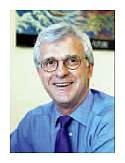
|

From the Provost
Welcome to Research at Boston University. With literally hundreds of laboratories, research centers, and libraries spread across the seventeen Schools and Colleges on our two campuses, Boston University research covers an enormous intellectual range, contributing to our understanding of issues from philosophy, sociology, and archaeology through the natural sciences and engineering to medicine, health, and technology. We address questions that are vital for the well-being of people and the environment and that nurture our inherent curiosity about our future and our past.
In this publication, which covers only a very small fraction of the ongoing research here at Boston University, we have highlighted some of the investigations of the timely topics of climate change and of biological adaptations in response to the dynamic environment. Time and again, observations have shown that small environmental changes can have an enormous impact on the survival of a vulnerable species, while at the same time some species have demonstrated a remarkable ability to adapt to changing conditions. An interesting case in point is illustrated on this year’s cover, which features Professor Karen Warkentin, a member of our biology department, and an instrumented clutch of frog eggs. Professor Warkentin’s research has revealed that these frog eggs have the ability to respond to perceived danger by hatching earlier than normal. In the section “Learning to Adapt,” we report on her work and on that of a number of other researchers who are examining the adaptive strategies of different species—all point to an encouraging robustness in the ability of organisms to survive change.
We humans are also proficient in adaptability, particularly in developing technologies to support our biological systems. The article “Moving Research into Action” highlights some of the innovative medical technologies being developed in collaborative projects involving faculty in our College of Engineering and School of Medicine. Several projects, funded with a $2.9 million, five-year grant from the Coulter Foundation, are described in this section. Among them is an automated glucose regulation system being developed by a team led by biomedical engineer Edward Damiano that will assume the work of damaged insulin-producing cells, thus transforming the lives of people living with diabetes.
Our current success in adaptability is a direct by-product of our past, and in the section “Bringing the Past to Life,” we chronicle archaeologist Kathryn Bard’s fascinating probe into the 4,000-year-old timbers that have been unearthed on the Red Sea coast in Egypt, remains from the pharaohs’ journeys to an ancient kingdom. Just as these relics provide insight into the distant past on another continent, archaeological finds in New England, investigated by BU archaeologist Mary Beaudry, provide insight into the nature of family life in the seventeenth century, from medicinal practices to food preferences.
As always, Boston University faculty are mentors and nurturers to the next generation of researchers. In “Students: Bringing a Fresh Eye to Research,” we highlight the “Rhythmic Rehab” research of Amir Lahav, whose study of the effect of music on brain function facilitated a clinical tool to promote movement in stroke patients. Junior Beth Ann Cimini, the recipient of a two-year Beckmann Grant for undergraduate research, is working with her neurobiology advisor, Professor Bill Eldred, to investigate how acetylcholine activates a neurotransmitter in the retina, ultimately unraveling the complexity of a simple visual image.
This past year at BU was one of enormous energy and excitement, highlighted by the inauguration of our tenth president, Dr. Robert A. Brown, Professor of Engineering and a member of the National Academy of Sciences, the National Academy of Engineering, and the American Academy of Arts and Sciences. Under his leadership, the Schools and Colleges of Boston University have sharpened their focus, strategically planned for the future, and collaborated on interdisciplinary projects that share the core mission of educating the best and the brightest to lead in the research of the future. We hope that this magazine challenges, inspires, and motivates you to learn more about the research endeavors described here as well as the thousands of other research projects under way on our campuses.
David K. Campbell
Provost |





